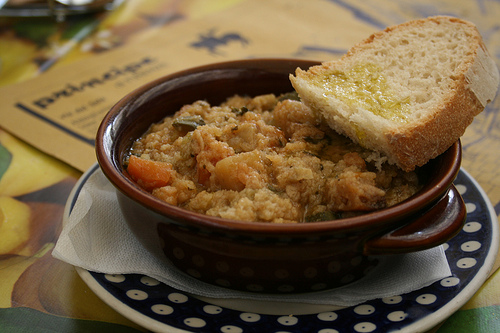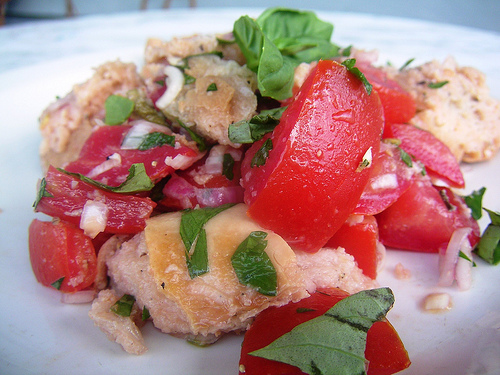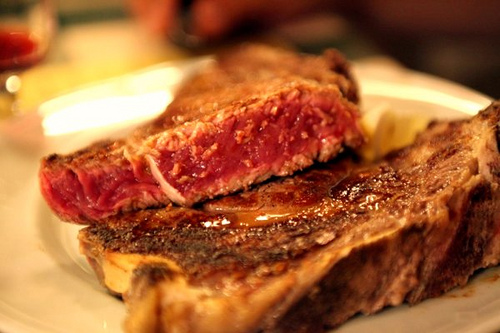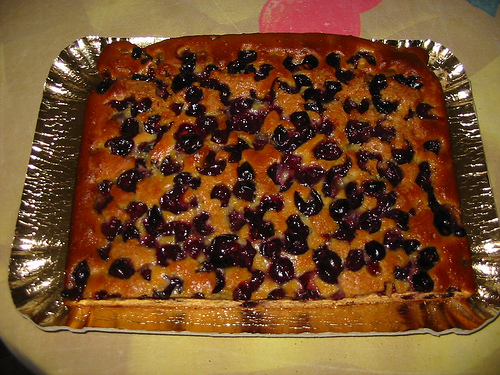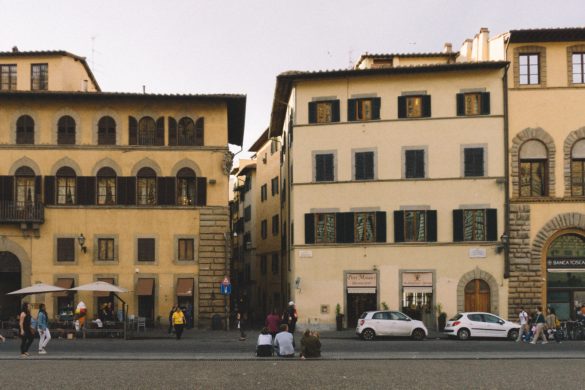If you’re a fan of beans, grilled meats, rustic Italian bread—eating it plain, or dipping it in olive oil—and wine, you will also be a fan of the food of the Tuscan region, particularly Florence. Traditional dishes of Florence are simple yet bursting with flavor. They originated from basic recipes concocted by the poor families of the region who needed to make use of the resources they had, and who did not waste anything. (Several delicious dishes—panzanella, ribollita, and pappa al pomodoro—derived from this method of “recycling food.”)
In Florence, dinnertime (as with other meals) is not a rushed occasion, and for the number of courses served for dinner, a long and relaxing dinner is best. The nice thing about a lengthy dinner is that it allows you to taste a bit of all the Florentine dishes. Dinner begins with the Antipasto. This starter course usually consists of a type of sliced salami ranging from prosciutto to soppressata, and crostini. Crostini di fegato , with a spread made of chicken or goose liver, capers, anchovies, onions, butter, and broth, is the most common of these canapés.
After the antipasto, the primi piatti, or first course is served. With the first course, you have the option of choosing a soup (most of which contain stale bread and beans), pasta, gnocchi, polenta, and risotto.
Ribollita
Although it is simple, ribollita is one of Florence’s most popular specialties. This hearty soup is made from cannellini beans, various vegetables, red cabbage, and chunks of stale bread. Making ribollita is actually a long process—approximately three days to be exact. The soup begins as traditional minestrone with vegetables and beans. The stale bread is added to the leftovers on the second day, and the whole pot is re-boiled (giving the soup its name) and served on the third day.
Pappa al Pomodoro
Another one of Florence’s notable soups is pappa al pomodoro, which is a bread and tomato soup. Like the ribollita, this dish came about because families did not want to waste leftover bread. This soup consists of tomatoes, bread, garlic, basil, and olive oil. Tomatoes did not appear in the original recipe because they had yet to be introduced to Europe. This original bread-mush was used as an early baby food.
Panzanella
If you’re not in the mood for soup but still want to taste the flaky Italian bread, try the panzanella, or stale-bread-salad. “Stale bread” may not sound very appetizing, but when paired with the other ingredients, you’ll definitely ask for more. The traditional salad is made with fresh vegetables, fresh tomatoes, and stale bread. It is then seasoned with basil, olive oil, vinegar, and a dash of salt and pepper. Other variations of panzanella include a mixture of lettuce, white or red wine, capers, anchovies, celery, carrots, red onion, cucumber, tuna, parsley, mint, bell peppers, lemon juice, and garlic.
Pappardelle
Pappardelle is one of Florence’s most popular pasta dishes for the primi piatti. The pasta used for this dish is thicker spaghetti, which is placed over hare sauce and then mixed in to coat the strands of pasta. The pasta is then seasoned with porcini mushrooms, meat sauces, artichokes, or whatever else the cook chooses.
Once you are finished with your primi piatti, it is time to move onto the secondi piatti, or second course. The secondi piatti is the main course, the bulk of the dinner. These dishes are sometimes served with side dishes of ceci all’olio (seasoned chickpeas), fritto miso (fried vegetables), and fagioli all’uccelletto (beans boiled and fried in tomato sauce and oil). In the secondi piatti, you’ll find meat, chicken, fish and seafood.
Bistecca alla fiorentina
When you visit Florence, ordering the bistecca alla fiorentina is a must! This T-bone steak has gained recognition as one of Florence’s greatest dishes. However, any steak cannot simply transform into the bistecca alla fiorentina; this Florentine specialty is so distinct because it is a special cut of Chianina beef. This thick cut of beef is grilled over a wood or charcoal fire and seasoned with salt, pepper, and olive oil. What also separates this steak from others is the fact that it is cooked “undone,” meaning it is only slightly cooked. The inside of the steak must remain tender and pink, while the outer layer is grilled and crispy. Now, if you do order the bistecca alla fiorentina, you may want to consider sharing it with your companion since these steaks tend to be huge, but definitely full of flavor.
Trippa alla fiorentina
As you peruse the menus in a Florence trattoria or osteria, you will notice that tripe frequently makes an appearance. Tripe, or cow’s stomach, is a popular ingredient in Florentine cooking. It is used in traditional dishes (trippa alla fiorentina) and in sandwiches (lampredotto). (I have a friend who rarely eats red meat, but even she raved about the lampredotto sandwiches!) You may be tentative to try the cow stomach, but after you try the trippa alla fiorentina, you may just change your mind. This dish is made by sautéing the tripe with olive oil, chopped onion, and tomatoes. Before it is served, it is topped with freshly grated parmesan cheese.
Pollo alla fiorentina
If you prefer chicken to red meat and cow stomach, opt for the pollo alla fiorentina. This savory dish consists of breaded chicken breasts covered in a sauce of spinach, onion, celery, cream cheese, paprika, and garlic. And of course, the dish is topped with parmesan cheese.
Casseruola alla fiorentina
The Italians are known for their exquisite pasta dishes. So if you didn’t get your pasta-fix with the primi piatti, the casseruola alla fiorentina will fulfill your craving. This casserole begins with covering pasta or noodles with a sauce of spinach, cream of mushroom soup, garlic, tarragon, and marjoram. Bits of sausage are thrown into the mix as well, and then the whole casserole covered with an egg and ricotta mixture. Many Florentines like to serve this dish at a cool temperature during the warm summer months.
By the end of a typical Florentine dinner, you will be happily stuffed from the night’s gourmet dishes. But even though your hunger may be satiated, you must still experience some of the region’s delectable homemade desserts.
Schiacciata alla fiorentina
Schiacciata alla fiorentina is sure to satisfy your sweet tooth. This dessert is a sweet sponge cake that is filled with cream, icing, or chocolate cream. It is then drizzled with icing sugar. Sciacciata alla fiorentina is most popular in February during the festival of Carneval, but you can enjoy this light and tasty sponge cake anytime!
Schiacciata con l’uva
For another sweet dessert, try the schiacciata con l’uva (sweet grape bread). This sweet bread is made by sprinkling fresh grapes with sugar and then baking them between two layers of dough. It is seasoned with olive oil and rosemary.
Castagnaccio
If you’re a fan of nuts, castagnaccio is the dessert for you. This chestnut cake is made from chestnut flour! Pine nuts, raisins, and rosemary leaves give this cake its sweet flavor.
Written by: Laura Photo Credits: talkoftomatoes / Robin Locker / thepinkpeppercorn / alexandra’s /
What’s your favorite Florentine specialty?

